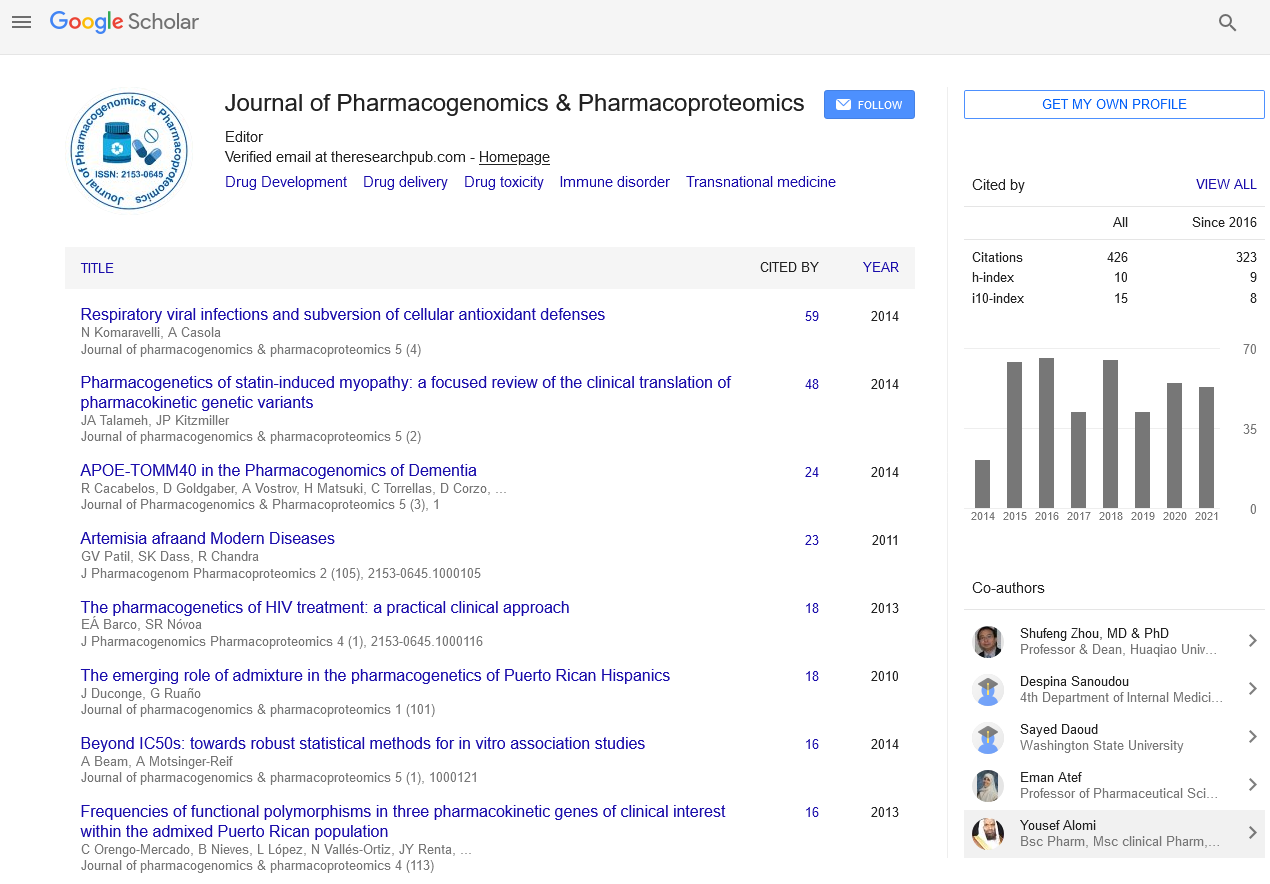Indexed In
- Open J Gate
- Genamics JournalSeek
- Academic Keys
- JournalTOCs
- ResearchBible
- Electronic Journals Library
- RefSeek
- Hamdard University
- EBSCO A-Z
- OCLC- WorldCat
- Proquest Summons
- SWB online catalog
- Virtual Library of Biology (vifabio)
- Publons
- MIAR
- Euro Pub
- Google Scholar
Useful Links
Share This Page
Journal Flyer

Open Access Journals
- Agri and Aquaculture
- Biochemistry
- Bioinformatics & Systems Biology
- Business & Management
- Chemistry
- Clinical Sciences
- Engineering
- Food & Nutrition
- General Science
- Genetics & Molecular Biology
- Immunology & Microbiology
- Medical Sciences
- Neuroscience & Psychology
- Nursing & Health Care
- Pharmaceutical Sciences
Study of breast cancer molecular markers in patients after neoadjuvant chemotherapy
2nd International Conference on Predictive, Preventive and Personalized Medicine & Molecular Diagnostics
November 03-05, 2014 Embassy Suites Las Vegas, USA
Vladimir S Chernyy and Gulyaeva L F
Posters: J Pharmacogenomics Pharmacoproteomics
Abstract:
Nowadays treatment of breast cancer (BC) is based on the tumor receptor status measured by the expression of ERs, PR, Her2/neu receptors. Our objective was to determine the gene expression of steroid receptors (ERα, ERβ, PR), cytokeratin 18 (KRT18) and specific microRNAs selected in silico in malignant breast tumors of patients untreated and treated with neoadjuvant chemotherapy (NAT). BC samples were obtained after surgery of patients who were treated in the State Regional Oncology Center (Novosibirsk) from 2011 to 2014 (n=122). We have found that the expression of ERα in patients after NAT decreased almost three times compared to the untreated group (p<0.05). To evaluate receptor status of BC, we used the semiquantitative real-time RT-PCR method. It should be noted that mRNA level for ER might not always correlate with the protein level. In this regard, one of the objectives of this study was to conduct comparative analysis of immunohystochemical (IHC) results and ERαmRNA level obtained by RT-PCR. We have found that the results for ERα receptor expression measured byIHC and RT-PCRmatch in 85.9% of cases. Besides, we determined the expression ofKRT18, a marker of tumor cell proliferation, in patientsunder study with various tumor phenotypes. Our results also showed that the expression level of KRT18 decreased 3.2 times in tumor tissue of patients treated with NAT compared with an untreated group (p<0.05). We also evaluated the expression of KRT18 depending on the tumor phenotype. We have found that patients with ER+PR+ tumors had an increased level of KRT18 in both groups under study 2.7 times on average in comparison with ER-PR+/- phenotype (p<0.05). The expression profile of selected miRNAs (miR-21, miR-221, miR-222, miR-155, miR-205, miR-146b, miR-20a, miR-200a, miR- 125b) was heterogeneous in all patients. We have shown an increased expression level of oncogenic miRNAs and a decreased level of tumor suppressor miRNAs. Thus, selected markers can be appropriate candidates for personalized treatment of BC patients.
Biography :
Vladimir S Chernyy graduated from Medical department of Novosibirsk State University (NSU) in July 2014. From September 2014 he is a clinical intern in Oncology atNSU. He started his research project in 2011at Institute of Molecular Biology and Biophysics of Siberian Branch of Russian Academy of Medical Science. The results of this work have been presented at several scientific conferences. He became laureate of Fund for Assistance to Small Innovative Enterprises in the scientific and technical sphere.


